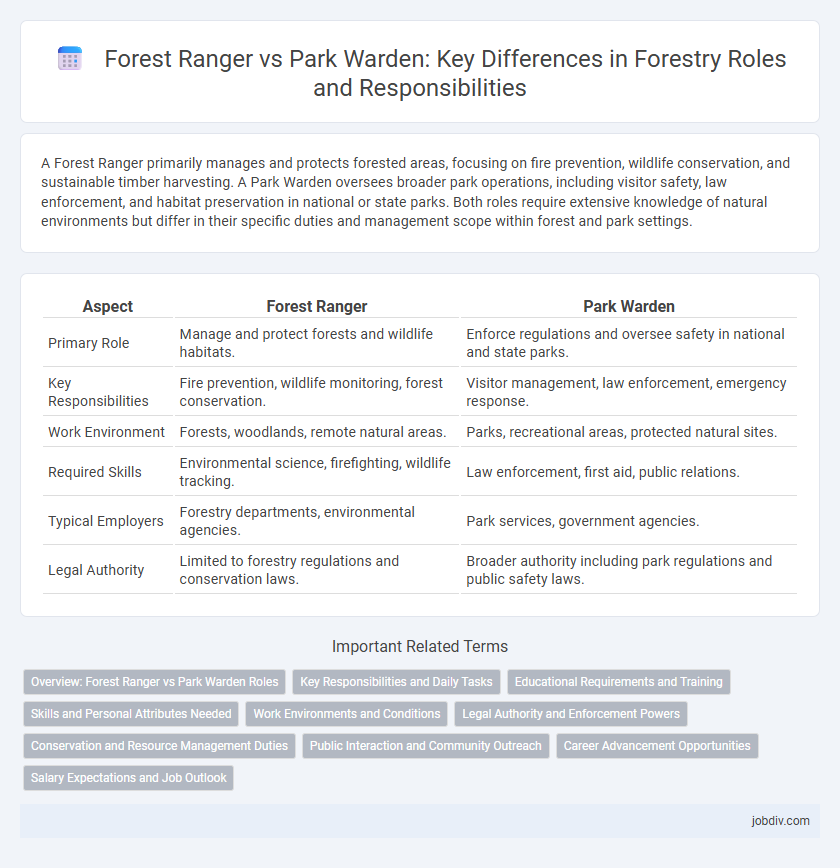A Forest Ranger primarily manages and protects forested areas, focusing on fire prevention, wildlife conservation, and sustainable timber harvesting. A Park Warden oversees broader park operations, including visitor safety, law enforcement, and habitat preservation in national or state parks. Both roles require extensive knowledge of natural environments but differ in their specific duties and management scope within forest and park settings.
Table of Comparison
| Aspect | Forest Ranger | Park Warden |
|---|---|---|
| Primary Role | Manage and protect forests and wildlife habitats. | Enforce regulations and oversee safety in national and state parks. |
| Key Responsibilities | Fire prevention, wildlife monitoring, forest conservation. | Visitor management, law enforcement, emergency response. |
| Work Environment | Forests, woodlands, remote natural areas. | Parks, recreational areas, protected natural sites. |
| Required Skills | Environmental science, firefighting, wildlife tracking. | Law enforcement, first aid, public relations. |
| Typical Employers | Forestry departments, environmental agencies. | Park services, government agencies. |
| Legal Authority | Limited to forestry regulations and conservation laws. | Broader authority including park regulations and public safety laws. |
Overview: Forest Ranger vs Park Warden Roles
Forest Rangers primarily focus on managing forest ecosystems, ensuring tree health, preventing wildfires, and overseeing sustainable forestry practices, while Park Wardens concentrate on protecting wildlife, maintaining park facilities, and enforcing regulations within national or state parks. Forest Rangers typically work in dense forest environments monitoring timber resources and conservation efforts, whereas Park Wardens engage closely with recreational management and visitor safety in protected parklands. Both roles require strong knowledge of environmental laws, but the scope of their duties differs based on the specific natural resources and public interaction involved.
Key Responsibilities and Daily Tasks
Forest Rangers oversee the protection and management of forested areas, focusing on wildlife conservation, fire prevention, and enforcing forestry laws. Park Wardens primarily maintain park facilities, guide visitors, and ensure safety within recreational areas, addressing issues like trail maintenance and visitor compliance. Both roles involve law enforcement and public education, though Forest Rangers emphasize ecological stewardship while Park Wardens prioritize visitor services.
Educational Requirements and Training
Forest Rangers typically require a bachelor's degree in forestry, natural resource management, or a related environmental science field, combined with specialized training in wildlife protection and fire prevention. Park Wardens often have similar educational backgrounds but may also receive extensive on-the-job training focused on visitor safety, law enforcement, and park regulations. Both roles demand physical fitness, knowledge of environmental laws, and certifications in first aid and emergency response to effectively manage forest and park resources.
Skills and Personal Attributes Needed
Forest rangers require strong knowledge of forestry management, wildlife biology, and navigation skills to monitor ecosystems and enforce environmental regulations effectively. Park wardens must possess excellent communication abilities, conflict resolution skills, and a deep understanding of visitor safety and park policies to manage public interactions and ensure compliance. Both roles demand physical fitness, keen observational skills, and a commitment to conservation and public service.
Work Environments and Conditions
Forest rangers primarily work in remote, densely wooded areas, often facing rugged terrain and variable weather conditions that require outdoor endurance and physical fitness. Park wardens typically operate within established recreational parks, balancing visitor safety and environmental conservation while managing well-maintained facilities and frequent public interaction. Both roles demand adaptability to fluctuating environments but differ in the balance between wilderness survival skills and public engagement responsibilities.
Legal Authority and Enforcement Powers
Forest Rangers typically hold broader legal authority to enforce laws related to wildlife protection, forestry regulations, and land use within national and state forests, including the power to issue citations, make arrests, and conduct investigations. Park Wardens, while also empowered to enforce park-specific regulations, often have jurisdiction limited to recreation areas and carry out duties focused on visitor safety, resource protection, and rule enforcement within designated park boundaries. Both roles require extensive knowledge of environmental law, but Forest Rangers generally possess wider enforcement powers across various forest management activities.
Conservation and Resource Management Duties
Forest Rangers primarily focus on conservation by overseeing sustainable timber harvesting, monitoring wildlife habitats, and enforcing forestry regulations to protect ecosystems. Park Wardens concentrate on preserving natural resources within park boundaries, managing visitor impact, and conducting educational programs to promote environmental stewardship. Both roles play critical parts in resource management, but Forest Rangers emphasize forest health and timber resources, while Park Wardens prioritize recreational area preservation and public safety.
Public Interaction and Community Outreach
Forest Rangers engage directly with the public by providing educational programs on forest conservation and safety, fostering community awareness about wildfire prevention and wildlife protection. Park Wardens focus more on enforcing park regulations, conducting patrols to ensure visitor compliance, and addressing safety concerns within park boundaries. Both roles collaborate with local communities to promote environmental stewardship but differ in the balance between enforcement and education.
Career Advancement Opportunities
Forest Rangers often have broader career advancement opportunities within forestry management, wildlife conservation, and environmental protection agencies, as they typically engage in resource management and law enforcement. Park Wardens primarily progress in roles related to visitor services, park safety, and tourism management, with fewer pathways into regulatory or scientific positions. Both careers benefit from specialized training, but Forest Rangers generally access higher-level leadership roles due to their involvement in complex ecosystem management and regulatory compliance.
Salary Expectations and Job Outlook
Forest rangers typically earn an average annual salary ranging from $35,000 to $55,000, with job growth projected at 5% over the next decade due to increased environmental conservation efforts. Park wardens often receive slightly higher compensation, averaging $40,000 to $60,000 per year, supported by steady demand in national and state parks for law enforcement and visitor safety. Both roles offer competitive benefits and opportunities for advancement, reflecting the growing emphasis on sustainable forest management and recreational area protection.
Forest Ranger vs Park Warden Infographic

 jobdiv.com
jobdiv.com